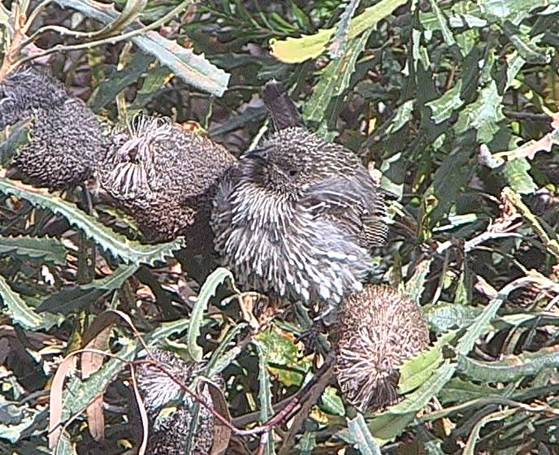Looks rounded to me unless I’m looking at the wrong
feather. I didn’t do any stills (plenty of snappers about) but the
below are from my video last week:

I mentioned the club-shape of several feathers, which
contributed to the sorry appearance. Is this a stage, and if so
what? From dead bird day:

Perhaps it is that little-known protective technique,
banksia-cone mimicry:

From:
[
Sent: Monday, 23 July 2007 11:16 AM
To:
Cc:
Subject: [canberrabirds] alula and ageing of honeyeaters
[SEC=UNCLASSIFIED]
I have received
an enquiry on ageing honeyeaters and thought I would reply "on-line".
I have summarised the technique that I applied when ageing the White-fronted HE
using Julian's great photo- http://www.flickr.com/photos/ozjulian/768995732/
The shape of
the tip of the longest of the alula feathers has been shown to be diagnostic of
age in honeyeaters (excluding the melithreptus honeyeaters). James Matthew who
was systematically examining plumages of birds in museums while working on
HANZAB with Birds Australia made this discovery and published an article in
Corella. James & I spent time banding and field testing this technique.
The alula is
located adjacent the greater coverts and on the leading edge of the wing. It
consists of 2-3 feathers that stickout a little in flight especially when
braking, hovering and manoeuvring.
What James
discovered was that the shape of longest alula feather varies according to age.
It is rounded in juvenile plumage and pointed in adult birds. The use of this
to age birds in the field requires close scrutiny (ie in the hand or thro' the
excellent photos presented in this forum). Another factor is when and to what
extent the juveniles lose their juvenile plumage (post-juvenile moult). In a
good season this may occur 2-3 months from fledging. In a poor season resources
seem to limit the extent of post-juvenile moult in autumn. It is common place
for juveniles to moult only their outer 6 of their primaries (most important
flight feathers) during post-juvenile moult. The alula usually is replaced in
post-juvenile moult and gets an intermediate alula with a sharper point. The
sharpness of this intermediate alula feather varies. The next complete moult
occurs during the following summer/autumn (bird 12 to 18 months old) and my
banding data shows that this intermediate alula is generally replaced by a
sharply pointed alula.
The
reason/advantage for this age dependant shape of alula is not known.
Now using
Dimitris' excellent photo of LWB below applying all that to answer this quiz:
- what
shape is the tip of the longest alula feather (see arrow)?
- how
old is it?
- why
is it here in Canberra?
-
-
-

